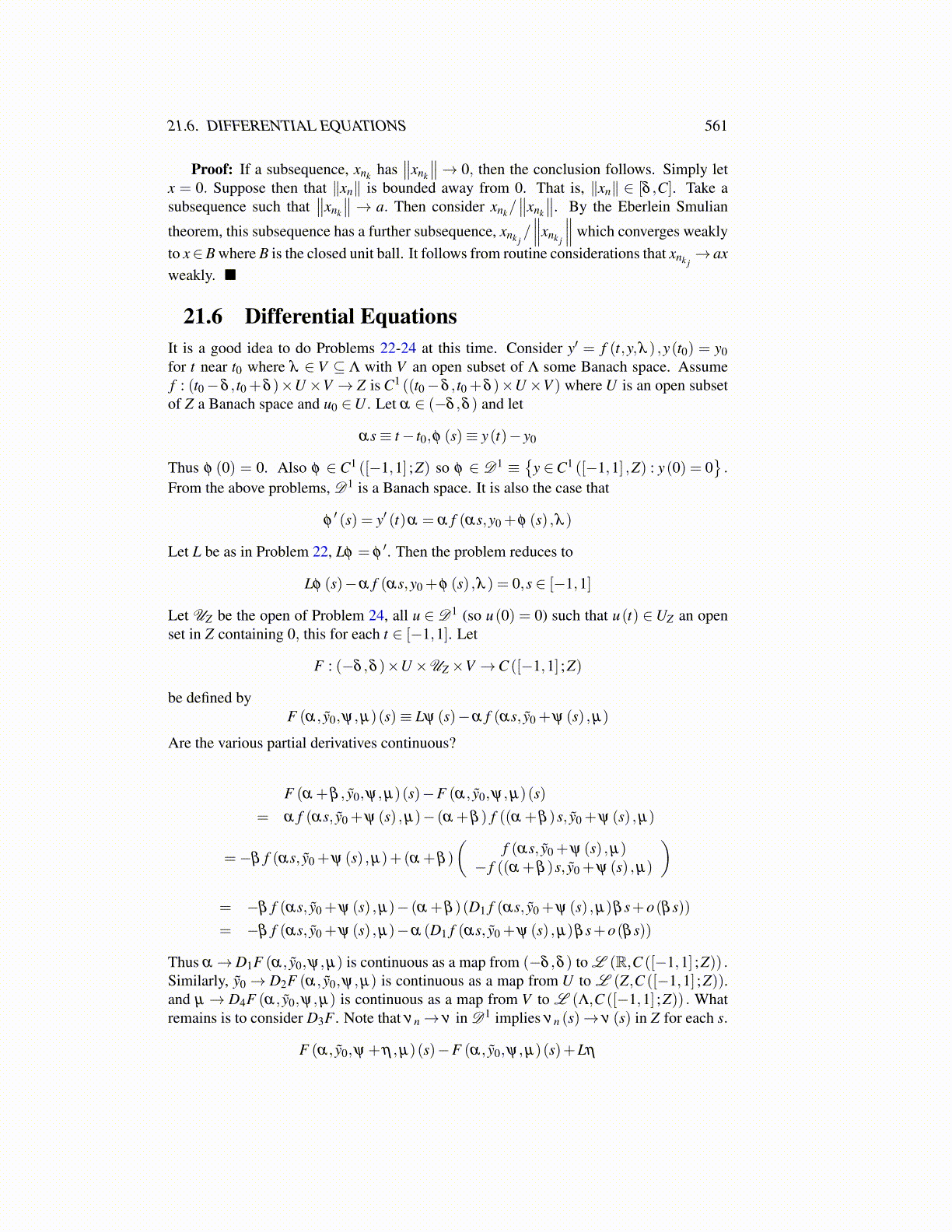
21.6. DIFFERENTIAL EQUATIONS 561
Proof: If a subsequence, xnk has∥∥xnk
∥∥→ 0, then the conclusion follows. Simply letx = 0. Suppose then that ∥xn∥ is bounded away from 0. That is, ∥xn∥ ∈ [δ ,C]. Take asubsequence such that
∥∥xnk
∥∥→ a. Then consider xnk/∥∥xnk
∥∥. By the Eberlein Smulian
theorem, this subsequence has a further subsequence, xnk j/∥∥∥xnk j
∥∥∥ which converges weaklyto x∈B where B is the closed unit ball. It follows from routine considerations that xnk j
→ axweakly. ■
21.6 Differential EquationsIt is a good idea to do Problems 22-24 at this time. Consider y′ = f (t,y,λ ) ,y(t0) = y0for t near t0 where λ ∈ V ⊆ Λ with V an open subset of Λ some Banach space. Assumef : (t0−δ , t0 +δ )×U ×V → Z is C1 ((t0−δ , t0 +δ )×U×V ) where U is an open subsetof Z a Banach space and u0 ∈U . Let α ∈ (−δ ,δ ) and let
αs≡ t− t0,φ (s)≡ y(t)− y0
Thus φ (0) = 0. Also φ ∈ C1 ([−1,1] ;Z) so φ ∈ D1 ≡{
y ∈C1 ([−1,1] ,Z) : y(0) = 0}.
From the above problems, D1 is a Banach space. It is also the case that
φ′ (s) = y′ (t)α = α f (αs,y0 +φ (s) ,λ )
Let L be as in Problem 22, Lφ = φ′. Then the problem reduces to
Lφ (s)−α f (αs,y0 +φ (s) ,λ ) = 0,s ∈ [−1,1]
Let UZ be the open of Problem 24, all u ∈ D1 (so u(0) = 0) such that u(t) ∈UZ an openset in Z containing 0, this for each t ∈ [−1,1]. Let
F : (−δ ,δ )×U×UZ×V →C ([−1,1] ;Z)
be defined byF (α, ỹ0,ψ,µ)(s)≡ Lψ (s)−α f (αs, ỹ0 +ψ (s) ,µ)
Are the various partial derivatives continuous?
F (α +β , ỹ0,ψ,µ)(s)−F (α, ỹ0,ψ,µ)(s)
= α f (αs, ỹ0 +ψ (s) ,µ)− (α +β ) f ((α +β )s, ỹ0 +ψ (s) ,µ)
=−β f (αs, ỹ0 +ψ (s) ,µ)+(α +β )
(f (αs, ỹ0 +ψ (s) ,µ)
− f ((α +β )s, ỹ0 +ψ (s) ,µ)
)= −β f (αs, ỹ0 +ψ (s) ,µ)− (α +β )(D1 f (αs, ỹ0 +ψ (s) ,µ)β s+o(β s))
= −β f (αs, ỹ0 +ψ (s) ,µ)−α (D1 f (αs, ỹ0 +ψ (s) ,µ)β s+o(β s))
Thus α→D1F (α, ỹ0,ψ,µ) is continuous as a map from (−δ ,δ ) to L (R,C ([−1,1] ;Z)) .Similarly, ỹ0→ D2F (α, ỹ0,ψ,µ) is continuous as a map from U to L (Z,C ([−1,1] ;Z)).and µ → D4F (α, ỹ0,ψ,µ) is continuous as a map from V to L (Λ,C ([−1,1] ;Z)) . Whatremains is to consider D3F . Note that νn→ ν in D1 implies νn (s)→ ν (s) in Z for each s.
F (α, ỹ0,ψ +η ,µ)(s)−F (α, ỹ0,ψ,µ)(s)+Lη